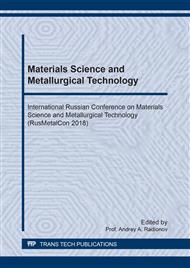p.673
p.678
p.684
p.690
p.696
p.702
p.709
p.719
p.726
Specialty of Сarbon-Carbid-Silicic Mixture Using (UKKS) as Substitute of Re-Carburizing Agent and Ferrosilicon for Grey Iron Melting
Abstract:
In the transition to modern high intensive processes of smelting there had been reversed technologies structures to get carbon content in cast iron. A re-carburizing agent, that can be one of the most significant reasons of occurrence of defects of the cast, and deformed metal and decrease of the level of properties have been identified. There was not only made the decarburizing agent of modern technology of production of pig-iron essential element (particularly synthetic), but also resulted in many of variants of its realization from the standpoint of level decarburizing, type, using re-carburizing method of decarburizing technological phase, where enter of carbonaceous materials. Particularly sharply process of execution re-carburizing influences receipt of synthetic pig-iron in induction crucible furnaces of industrial frequency from metal works, which contained 80-90% of steel breakage. Then, it is necessary to raise the content of carbon from 0,3 to 3,0-3,8% (depending on the pig-iron mark). It forces foundry enterprises to approach with big care at a choice of existing materials, which it is possible to use as decarburizing and to verify carefully, which is appearing at the market. In work application there are considered variants of using carbon-carbide-silicon mixture UKKS-31 at melting of grey pig-iron in induction, crucible furnaces, intended for pig-iron melting. The cost comparison is presented between traditional technology and with using mix UKKS-31.
Info:
Periodical:
Pages:
696-701
Citation:
Online since:
February 2019
Keywords:
Price:
Сopyright:
© 2019 Trans Tech Publications Ltd. All Rights Reserved
Share:
Citation:


